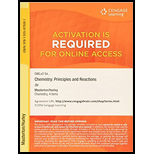
Concept explainers
(a)
Interpretation:
The equation to show the acidic nature of the given species in water according to the Bronsted-Lowry model should be written.
Concept introduction:
According Bronsted-Lowry acid and base theory, acids are substance which loses protons
For example:
Here, HA is an acid as it donates a proton to form
Similarly,
Here,
Answer to Problem 10QAP
Explanation of Solution
The given species is
On reaction with water, it can act as an acid by donating hydrogen ion to the water. The reaction is shown as follows:
In the above reaction,
(b)
Interpretation:
The equation to show the acidic nature of the given species in water according to the Bronsted -Lowry model should be written.
Concept introduction:
According Bronsted-Lowry acid and base theory, acids are substance which loses protons
For example:
Here, HA is an acid as it donates a proton to form
Similarly,
Here,
Answer to Problem 10QAP
Explanation of Solution
The given species is
On reaction with water, it can act as an acid by donating hydrogen ion to the water. The reaction is shown as follows:
In the above reaction,
(c)
Interpretation:
The equation to show the acidic nature of the given species in water according to the Bronsted-Lowry model should be written.
Concept introduction:
According Bronsted-Lowry acid and base theory, acids are substance which loses protons
For example:
Here, HA is an acid as it donates a proton to form
Similarly,
Here,
Answer to Problem 10QAP
Explanation of Solution
The given species is
On reaction with water, it can act as an acid by donating hydrogen ion to the water. The reaction is shown as follows:
In the above reaction,
(d)
Interpretation:
The equation to show the acidic nature of the given species in water according to the Bronsted -Lowry model should be written.
Concept introduction:
According Bronsted-Lowry acid and base theory, acids are substance which loses protons
For example:
Here, HA is an acid as it donates a proton to form
Similarly,
Here,
Answer to Problem 10QAP
Explanation of Solution
The given species is as follows:
On reaction with water, it can act as an acid by donating hydrogen ion to the water. The reaction is shown as follows:
In the above reaction,
(e)
Interpretation:
The equation to show the acidic nature of the given species in water according to the Bronsted -Lowry model should be written.
Concept introduction:
According Bronsted-Lowry acid and base theory, acids are substance which loses protons
For example:
Here, HA is an acid as it donates a proton to form
Similarly,
Here,
Answer to Problem 10QAP
Explanation of Solution
The given species is as follows:
On reaction with water, it can act as an acid by donating hydrogen ion to the water. The reaction is shown as follows:
In the above reaction,
(f)
Interpretation:
The equation to show the acidic nature of the given species in water according to the Bronsted-Lowry model should be written.
Concept introduction:
According Bronsted-Lowry acid and base theory, acids are substance which loses protons
For example:
Here, HA is an acid as it donates a proton to form
Similarly,
Here,
Answer to Problem 10QAP
Explanation of Solution
The given species is as follows:
On reaction with water, it can act as an acid by donating hydrogen ion to the water. The reaction is shown as follows:
In the above reaction,
Want to see more full solutions like this?
Chapter 13 Solutions
Owlv2, 4 Terms (24 Months) Printed Access Card For Masterton/hurley's Chemistry: Principles And Reactions, 8th
- Rank the following hydroxides in order of increasing aqueous basicity: Al(OH)3, B(OH)3, In(OH)3.arrow_forwardWhat is the degree of ionization (i) for Na₃PO₄(aq)?arrow_forwardOne and only one combination of cobalt salt and solvent should have turned blue, thusindicating the presence of [CoCl4]2− ion. Explain why only this combination underwent a reactionand the others did not.arrow_forward
- Account for the following : (a) La(OH)3 is more basic than Lu(OH)3 (b) Zn2+ salts are white. (c) Most of transition metals do not displace hydrogen from dilute acids why?arrow_forwardWhen dimethoxyethane reacts with I+, it forms a Lewis acid-base complex in which both oxygens bond to the iodine. What is the electron group geometry (from VSEPR theory) of the complex? Make a good Lewis drawing of the Lewis complex, using dash-wedge notation and correctly showing formal charges and the location of the lone pairs.arrow_forwardWould you expect an aqueous solution of manganese (VII) oxide to have a ph greater or less than 7.0? Justify your answerarrow_forward
- Cations of which of the following categories will give soluble basic oxides? Select one or more: a. very strongly acidic cations b. moderately acidic cations c. nonacidic cations d. feebly acidic cationsarrow_forwardBased on the pH measured for the solution of (NH4)2CO3, is NH4+ is a stronger acid or is CO2−3 stronger base? and Why?arrow_forwardAll the following salts are alkaline except LiClO NH4NO3 SrCrO4 K2HPO4arrow_forward
 ChemistryChemistryISBN:9781305957404Author:Steven S. Zumdahl, Susan A. Zumdahl, Donald J. DeCostePublisher:Cengage Learning
ChemistryChemistryISBN:9781305957404Author:Steven S. Zumdahl, Susan A. Zumdahl, Donald J. DeCostePublisher:Cengage Learning ChemistryChemistryISBN:9781259911156Author:Raymond Chang Dr., Jason Overby ProfessorPublisher:McGraw-Hill Education
ChemistryChemistryISBN:9781259911156Author:Raymond Chang Dr., Jason Overby ProfessorPublisher:McGraw-Hill Education Principles of Instrumental AnalysisChemistryISBN:9781305577213Author:Douglas A. Skoog, F. James Holler, Stanley R. CrouchPublisher:Cengage Learning
Principles of Instrumental AnalysisChemistryISBN:9781305577213Author:Douglas A. Skoog, F. James Holler, Stanley R. CrouchPublisher:Cengage Learning Organic ChemistryChemistryISBN:9780078021558Author:Janice Gorzynski Smith Dr.Publisher:McGraw-Hill Education
Organic ChemistryChemistryISBN:9780078021558Author:Janice Gorzynski Smith Dr.Publisher:McGraw-Hill Education Chemistry: Principles and ReactionsChemistryISBN:9781305079373Author:William L. Masterton, Cecile N. HurleyPublisher:Cengage Learning
Chemistry: Principles and ReactionsChemistryISBN:9781305079373Author:William L. Masterton, Cecile N. HurleyPublisher:Cengage Learning Elementary Principles of Chemical Processes, Bind...ChemistryISBN:9781118431221Author:Richard M. Felder, Ronald W. Rousseau, Lisa G. BullardPublisher:WILEY
Elementary Principles of Chemical Processes, Bind...ChemistryISBN:9781118431221Author:Richard M. Felder, Ronald W. Rousseau, Lisa G. BullardPublisher:WILEY





